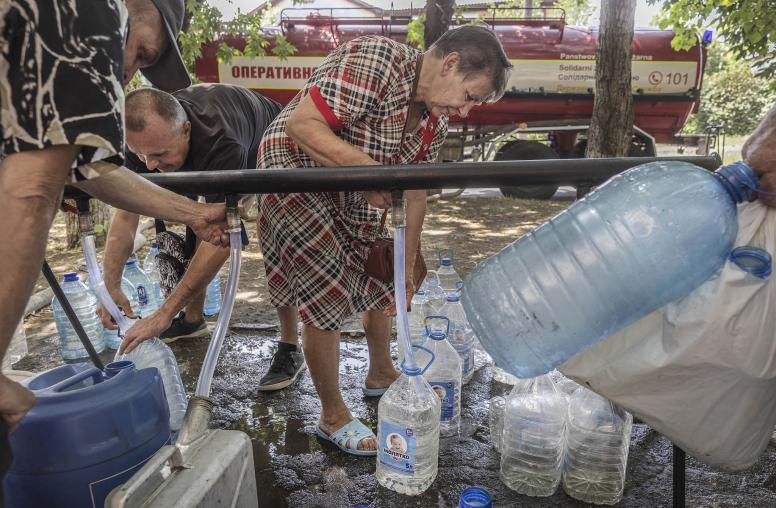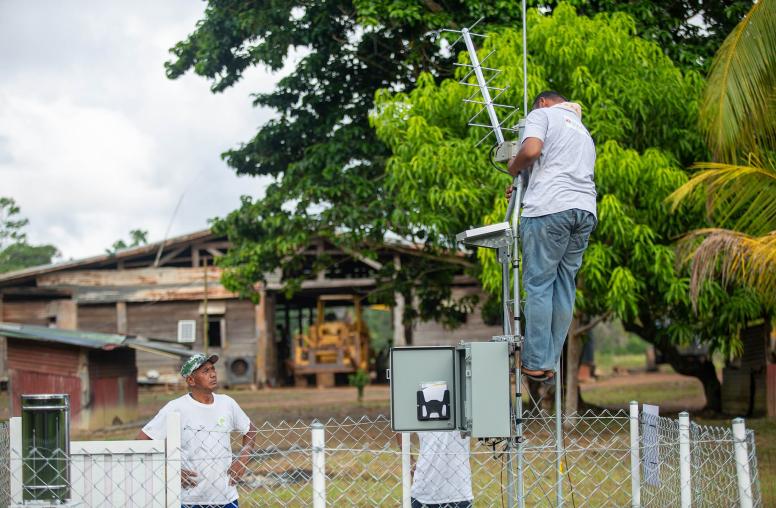The Intertwined Futures of Climate Action, Fragility and Peacebuilding
As our understanding of the climate crisis becomes more complex, so too must the strategies designed to address it.
Crises are often described narrowly; clearly differentiated by the aspect of society they impact, such as the economy or national security. But the COVID pandemic and looming climate crisis have shown that lines distinguishing one crisis from another aren’t as distinct as they may seem, and that underlying issues like COVID can impact a number of sectors simultaneously. Navigating the intersection of health, economic, governance and humanitarian issues has become the defining challenge of the pandemic response, offering policymakers a preview of how long-term challenges — such as climate change — will require a similarly holistic and coordinated strategy that brings together disciplines that have historically been independent.

As climate change research has progressed, the daunting scale of its effects has come into view. “Climate will affect every human-made system … where and how we live, how we grow our food, water access, everything is affected,” said Alice Hill, a senior fellow for energy and the environment at the Council on Foreign Relations, at a USIP virtual event co-hosted with the Woodrow Wilson Center.
This looming crisis has prompted a set of ambitious commitments from the Biden administration, making clear they intend to embed climate action into all aspects of U.S. policy — including their foreign and national security agendas. As the Biden administration’s vision for climate becomes clearer, experts say it will be critical to break down walls between those working on climate and those working on fragility and peacebuilding.
How Climate and Conflict Intersect
“These are not separate agendas in the real world, where countries can be affected simultaneously by climate change, conflict, famine, pandemics and on,” said Cynthia Brady, a global fellow at the Woodrow Wilson Center. “Many of the countries around the world that are most affected by fragility and conflict are the same places where we face the steepest climate-related challenges.”
The data bears this out. The World Bank estimates the effects of climate change could push another 100 million people into poverty in the coming years. And research shows that another degree of global warming will be associated with a 10-20 percent heightened risk for conflict.
Meanwhile, clashes over land and natural resources, access to critical services, and other indicators of fragility have increasingly been linked to the reverberating effects of climate change, with the Darfur conflict being labelled as the first conflict driven primarily by environmental factors. “This is our baseline now,” said Liz Hume, the acting president and CEO of Alliance for Peacebuilding. “Climate change is a threat multiplier. It is impacting conflicts. It is making them worse.”
And even when climate change is not directly associated with conflict, its effects are still felt. “Climate sets the parameters for everything,” said Erin Sikorsky, deputy director of the Center for Climate and Security. In Ethiopia, where ethnic and cultural tensions have left the country on the verge of increasingly violent conflict, increasing temperatures and decreasing rainfall have impacted agriculture and food supplies. While this has not directly contributed to the crisis, Sikorsky said the added stress creates a higher sensitivity to shocks in a region struggling to stabilize.
The profound stress that climate change places on governance, particularly in fragile states, often means that governments struggle to keep up with administrating basic social services, driving them deeper into fragility — and creating situations vulnerable to violent conflict. “We see it in the communities as well [as the data],” said Dina Esposito, vice president of technical leadership at Mercy Corps . “We hear about young men who are willing to take increased risk to provide for their families … we hear about a willingness to fight for resources. You’ve got climate change creating profound stress, which is potentially fueling conflict and creating tension.”
This stress in turn precludes governments from addressing climate and environmental issues, as they become either preoccupied with solving the fragility crisis or are incapable of acting altogether. “It’s this vicious cycle, as crucial climate change adaptation goals become impossible to achieve,” said Hume.
The Need for a New Approach
U.S. government activities on fragility, peacebuilding and climate have traditionally been siloed, with each sector focused on their immediate purview without much collaboration on shared issues.
Additionally, many programs are focused on responding to near-term shocks, with insufficient attention paid to planning for the future. “Does it make sense to promote maize production in southern Malwai? What are the implications of that 10 years from now?” said Esposito. As research allows for better predictions and modeling of climate change, Esposito argues that programs must take into account long-term sustainability rather than solving short-term issues and find ways to promote development that can endure future climate shocks.
And just as experts say our time horizon needs to expand, so too must our understanding of the relationship between climate and fragility. “We should be thinking about the ways in which climate affects social, political and economic factors,” said Brady. “Framing the conversation less around causality and more around potential risk pathways.”
Although analysis of peacebuilding and climate change is getting better and more nuanced, “the climate-conflict research is still really nascent … there’s a lot we really need to learn,” said Esposito. With climate change already impacting conflicts around the world, the lack of research has left some experts scrambling to catch up. “There’s been a whole series of timelines that have been already missed,” said Esposito. Despite the delays, there is still a path forward for climate-conscious peacebuilding, “but it won't happen if we don’t diagnosis problems more holistically,” said Brady.
Creating a Sustainable, Collaborative Strategy
For those working on fragility and peacebuilding, the moment calls for urgency — climate action cannot be seen as a separate discipline, but rather an integral part of how they approach their mission. “I like to think of it as layers. How do you add this climate change lens and layer on to conflict and on the fragile states?” said Sikorsky.
The U.S. Global Fragility Act of 2019 (GFA) offers policymakers an important opportunity to operationalize such an approach. The law requires the State Department, USAID, the Defense Department and other agencies to put in place, for the first time, a comprehensive strategy to address state fragility, violent conflict and extremism. These policy changes have opened up a window of opportunity for policymakers to expand their understanding of conflict to include climate change, and “while these concepts seem pretty obvious, they would revolutionize U.S. foreign assistance,” said Hume.
In five countries, agencies are required to test the new approach to fragility and conflict. The new approach is a prime opportunity to also test out a climate-conscious peacebuilding and development strategy, allowing experts to collaborate “so that an education program isn't just an education program, and a climate change program wouldn't just be a climate change program,” said Hume.
Current research shows that a focus on improving governance is a strong foundation for both improved climate action and sustainable peace outcomes, offering a good starting point for future efforts. “We often look to these technical fixes without understanding the governance issues that have been brought up. Trust in government, local dynamics, all of these things that are more intangibles will make the difference as to whether things on the ground [will] work or not,” said Sikorsky.
Meanwhile, the local government infrastructure designed to address climate change needs to be rebuilt. “Our technical assistance has been decimated,” said Hume, while praising the Biden administration's proposed $2.5 billion increase in international climate programs as a great first step in getting back on track.
Going forward, policymakers will need to ensure U.S. policies are informed by the latest research on how to support institutions that are resilient to climate and security shocks in vulnerable countries.
“We're still at that starting point with many of our decision-makers,” in terms of climate change knowledge, said Hill. “We still don't have a uniform understanding of what’s at stake.” Hill and others suggested that scientific literacy needs to be brought into the national security community in a serious way, including among region- and country-specific staff and programs, who are often overlooked in the process.
Policymakers also need to stay committed to these programs over the long term (the GFA requires 10-year country plans). Ultimately, it’s important to remember that “there’s no technocratic solution to peace,” Esposito said, and that various disciplines and sectors will need to rally around a shared outcome of resilience. As Brady concluded, “interdisciplinary thinking, adaptation and creativity will be the hallmarks of how we get this done.”



